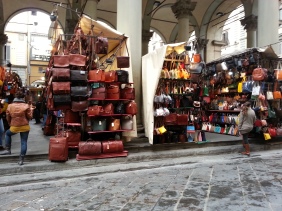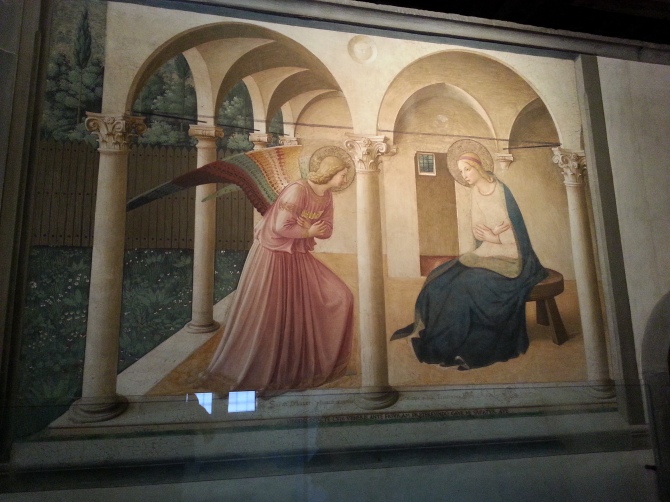Florence was a busy and wealthy city in the Renaissance. An independent city-state, it was a major center for the weaving and dying of wool imported from Northern Europe and silk from home-grown Italian silkworms. Merchants made lots of money exporting their cloth all over Europe and had their own agents in most major cities. To finance their ventures many merchants also became bankers on a local, as well as international, level.
The Medici, one of these powerful families, used some of their great wealth to encourage and finance the work of a number of artists. That patronage, together with other factors, such as the rivalry among Italian city-states and the great interest in classical writings and art, helped fuel the Renaissance.
Florence produced many of the biggest names of the Renaissance:  Ghiberti (the bronze doors of the Baptistry),
Ghiberti (the bronze doors of the Baptistry),  Brunelleschi ( the architect who finally figured out how to put a dome on the cathedral),
Brunelleschi ( the architect who finally figured out how to put a dome on the cathedral),
Donatello ( revolutionized sculpture with relaxed poses and realistic figures), and of course Leonardo da Vinci and Michelangelo.
Today 1000s of tourists spill out of the Santa Maria Novella train station into a city that is still wealthy and busy. Many come for the art. Even off-season, there’s a line to get into the cathedral, and an even longer line to climb up into its iconic red-brick dome, which towers over everything else in town. Reservations are needed to get into Florence’s top art museums: the Uffizi is home to one of the best collections of Renaissance art, and Michelangelo’s David is the Accademia’s big prize. Even with a reservation, both museums are wall-to-wall people. One man actually rested his selfie-stick-mounted camera on Wes’ head to get a photo of a famous painting!
 But Florence’s main streets and piazzas are busy, too. It’s a shopper’s paradise, with high-end fashions and home goods filling the stores, and merchandise overflowing into several big outdoor markets. Venders of leather products are everywhere, and it’s a toss-up which is stronger—the sales pitch, or the smell of the leather!
But Florence’s main streets and piazzas are busy, too. It’s a shopper’s paradise, with high-end fashions and home goods filling the stores, and merchandise overflowing into several big outdoor markets. Venders of leather products are everywhere, and it’s a toss-up which is stronger—the sales pitch, or the smell of the leather!
Tiny, expensive jewelry shops line the Ponte Vecchio.
 They have thick, metal-studded wooden shutters, completely closing over the shops at night, probably just as they did back in Renaissance times. Back then, though, this bridge was home to butcher shops since it was so handy to just open a back window and dump the waste into the river. But the Medici grew tired of the smell on their way from palace to work, and goldsmiths took over.
They have thick, metal-studded wooden shutters, completely closing over the shops at night, probably just as they did back in Renaissance times. Back then, though, this bridge was home to butcher shops since it was so handy to just open a back window and dump the waste into the river. But the Medici grew tired of the smell on their way from palace to work, and goldsmiths took over.
The streets are busy all day, but even more at night. 

 Italians with babies in strollers and dogs on leashes, and tired tourists still snapping photos, throng the streets, walking, shopping, visiting, and dining in outdoor restaurants and enjoying gelato. Businesses stay open late, and crowds gather around street musicians and puppeteers.
Italians with babies in strollers and dogs on leashes, and tired tourists still snapping photos, throng the streets, walking, shopping, visiting, and dining in outdoor restaurants and enjoying gelato. Businesses stay open late, and crowds gather around street musicians and puppeteers. 
 People selling pastel-colored selfie sticks or little gizmos that light up when thrown into the air, thread their way through the crowds. It’s fun, but can become overwhelming.
People selling pastel-colored selfie sticks or little gizmos that light up when thrown into the air, thread their way through the crowds. It’s fun, but can become overwhelming.
The Artist and the Painting
A quiet place to rejuvenate and reflect is sometimes needed, and there is one in the Museum of San Marco that occupies what was once a Dominican monastery. Surrounding its own quiet cloister, it has some of the most beautiful art in Florence, but not as many people know about it.
In the 1430s Dominican monks took over this monastery that dated from a much earlier time and began renovations financed by Cosimo de’ Medici the Elder. Cosimo kept a cell here for times of retreat (I guess he got tired of the hustle and bustle, too!),  and near the end of the century, the reformer, Savonarola, was assigned as a teacher here. You can see their cells and studies.
and near the end of the century, the reformer, Savonarola, was assigned as a teacher here. You can see their cells and studies.
 As part of the renovation, one of the Dominicans, Fra Giovanni, soon known as Fra Angelico, painted frescoes of the life of Christ throughout the monastery and in each of the monks’ cells. Once only the monks could see these, but today everyone can wander through the quiet halls and look into each of the small cells. It’s startling to see a colorful fresco of the Nativity or the Baptism on its wall. Because of the plain surroundings, the frescoes stand out with moving clarity.
As part of the renovation, one of the Dominicans, Fra Giovanni, soon known as Fra Angelico, painted frescoes of the life of Christ throughout the monastery and in each of the monks’ cells. Once only the monks could see these, but today everyone can wander through the quiet halls and look into each of the small cells. It’s startling to see a colorful fresco of the Nativity or the Baptism on its wall. Because of the plain surroundings, the frescoes stand out with moving clarity.
One large fresco, The Annunciation, greeted the monks, and now greets us, at the top of the stairs to the cells. The stairs turn a corner about three quarters of the way up so that you don’t see it until you’re right below it. Then it fills your eyes as you climb the rest of the way up.
This Annunciation is, I think, one of the most beautiful of all annunciation paintings. It depicts a moment of quiet serenity in a cloister not unlike the one just downstairs. The archangel, Gabriel, bows before Mary as he greets her and announces that she will bear the Christ Child. Mary’s hands are folded in submission to God’s will.
Gabriel and Mary stand out against the plain walls and floor of the cloister. But the more you look, the more the simplicity of the receding columns and arches, resulting in varying shapes of shadow and light, draw you in with their beauty and frame the quiet drama within.
As befitting an Archangel, Gabriel’s multi-colored, almost rainbow-like, wings are eye-catching, and the gold on them is repeated in the embroidery on his robe. The robe drapes in graceful folds that show rich shades and tints of pink.
That pink is repeated in just two other places—the floor of the cell behind Mary and her headband. That repetition allows our eyes to leave the heavenly being and come to rest upon the humble woman seated on a plain wooden stool. Mary’s clothing is also plain, but contrasting with her white robe is a dark blue mantle that frames her face and arms. Fra Angelico didn’t want you to miss her sweet expression and submissive gesture.
Behind Gabriel is a garden with delicate flowers and lush greenery. A walled garden is often used in annunciation paintings to symbolize Mary’s purity and virginity. It also reminds viewers of the Garden of Eden and what mankind lost when Adam and Eve sinned.
Some Devotional Thoughts
Fra Angelico was a Dominican monk who took his vows very seriously and eventually became prior of the monastery of San Marco. The Dominican order was founded, as were the Franciscans, when Europe was in transition from a mostly rural economy to a time of more trade and bigger cities. Traditional monasteries were self-contained communities, often in very rural areas, and, therefore, couldn’t easily help city dwellers.
Dominicans and Franciscans didn’t stay in their cloisters. They went out into the world to preach the gospel in a down-to-earth way and minister to people in need. They were very dedicated and effective, especially in the cities. During the years of the Black Death thousands of these friars died ministering to the sick.
When the San Marco friars returned at the end of a busy day, they passed through a quiet cloister, but then had many stairs to climb to reach their cells.
As they turned the corner and gazed up at the angel Gabriel, were they reminded of the vast splendor of God and His heaven?
When they looked at Mary, were they reminded of their own humble estate?
When they looked at the garden, were they reminded of the Garden of Eden and mankind’s fall into sin and separation from God?
When they looked at the cloister and thought of their own small cloister downstairs, did they long for a permanent rest from their labors, especially against their own and others’ sins?
Did they then think on the amazing love and grace God has given us fallen humans, in the gift of His Son?
Were they amazed anew by the miracle of God taking on human flesh and being born of a virgin to dwell among His people?
And did they praise God for opening the Way to return to a renewed and eternal garden of peace with God through faith in Christ’s perfect life, sacrificial death, and resurrection?
Most of us today can’t withdraw into a monastery to get away from the hustle and bustle of what has become a very materialistic holiday season. But I challenge you this month to find a quiet space to think on God’s splendor, your humble estate, your longing for that permanent rest Christ can give you from struggling with your own sin and a sinful world, and praise God for opening the Way through Christ back to the Garden.
Don’t miss the next Picture Lady post. Sign up to receive it by email.
The images in this blog are used for educational purposes only





Kathy, Please keep us this delightful message. I really enjoy receiving them. Your Mom would be so proud! Merry Christmas to you and your family. Chris Bennett
LikeLike
Thank you so much, Chris! Merry Christmas to you and your family, too!
LikeLike
Hi Kathy, I really enjoy your reviews and hope you’ll keep up the good work. Your Mom would be so proud. Chris Bennett
LikeLike
Hey Kathy – you’ve hit a Home Run with this post! What a fabulous trip you’ve just been on! This old engineer has learned a whole lot about Florence, fresco art, and The Annunciation……I knew about Gabriel telling Mary what was going to happen but did not know that it was called The Annunciation. Thanks for your wonderful art history lesson. Randy
LikeLike
Thank you so much,Randy. I’m so glad you enjoyed it!I love your comments!
LikeLike
Here it is the last day of January and I just read and viewed your post of Dec. 8th. What a joy! Kathy, you are a treasure trove of knowledge about art history. Just wish I could remember what I read. You have an amazing ministry and it so honors God!
LikeLike